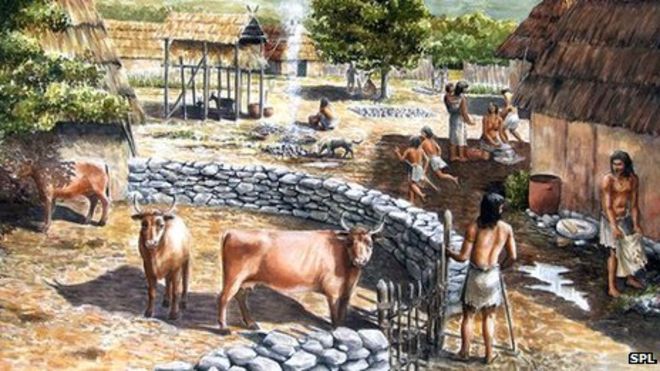The Paleolithic Era began nearly two hundred thousand years ago, and lasted for tens of thousands of years. The Neolithic Era followed, and was introduced with the rise of plant and animal domestications between twelve and six thousand years ago. The thought of the human species being around for so long is interesting to think about, especially given the fact that humans originated from ancestors in East Africa that date four to five million years back.1 Our ancestors must have been doing something right, considering the fact that the human species survived for such a long time without the technology, medicine, and overall knowledge that we have today. Once we realize that our ancestors from two hundred thousand years ago were so successful in their pattern of living during the Paleolithic Era, we must ask ourselves what changes occurred during the transitional period between the Paleolithic and Neolithic Eras, and whether or not those changes were good.
Humans living during the Paleolithic Era lived in egalitarian societies, that is, societies in which the inhabitants practiced political, economic, and social equality, where each individual in society held the same social status as all other members of society. This egalitarian society was made possible because of their way of life at the time. People lived in small communities of no more than a hundred, and they relied on hunting and gathering as their means of sustenance. They were necessarily migratory because of the limits of their environment, so there was not a real possibility of staying in one place for an extended period of time. Their migratory existence made the accumulate wealth impossible; in fact, wealth was an inconceivable concept for hunters and gatherers. As a result, everyone in society had the same economic standing; since there were no economic differences among individuals of society, there were no social classes. Nor was there the formation of political classes during this time either. Furthermore, everyone—men and women alike—played relatively equal roles in contributing to the survival and well-being of the community.2
This way of life and the egalitarian nature of society remained intact for centuries after the beginning of domestications. However, as hunter and gatherer societies transitioned to herding and farming, and hence to a sedentary lifestyle, a shift began that transformed those societies from egalitarian to stratified societies.3 This shift is one of the major distinctions between the Paleolithic and Neolithic Eras; again, this shift is a direct result of plant and animal domestication, or herding of animals and agriculture.

Agriculture gave the people of the Neolithic Era reassurance that their food supply would be constant; however, it also caused the rise of new issues that communities in the Paleolithic Era never dealt with. For example, the rise of agriculture prompted humans of the time to live in clustered societies, and therefore fostered the spread of parasites and several infectious diseases.4 Furthermore, since agriculture promoted a sedentary lifestyle, Neolithic societies were enabled to accumulate wealth in the form of surplus food supplies. This accumulation of wealth allowed for the social structure of the Neolithic Era to quickly become vastly different from that of the Paleolithic Era due to a focus on the “interests, behavior, and social role(s) of individuals versus a collective group of individuals.”5
Essentially, in the transition between the Paleolithic and Neolithic Eras, human society suffered a loss of social and economic equality and a general respect for all people, and replaced it with a system that required the separation of people based on superficial characteristics such as wealth, power, and gender. The interesting thing about the new class and gender distinctions that accompanied the beginning of the Neolithic Era is that for hundreds upon thousands of years, the human species had managed to exist without the use of class separations. Instead, it was the common practice of communities during the Paleolithic Era that there was no need to cause separation between persons because everyone made an equal contribution to the development and management of their small communities. Ironically, during the Neolithic Era, the rise of agriculture allowed the development of class divisions, as well as the establishment of governments that ruled harshly over society’s non-elites.6
These changes in social structure that arose during the Neolithic Era as a result of agriculture still persist in our societies today; there are still deep and widespread class divisions; there is still gender inequality, and there is still a sense of excessive elite control over the working class.7 Overall, social changes that occurred during the transition between the Paleolithic and Neolithic Eras exhibited a loss in important practices that we have only recently attempted to restore.
- Jerry H. Bentley, Herbert F. Ziegler, and Heather E. Streets-Salter, Traditions & Encounters: A Brief Global History From the Beginning to 1500, Fourth, vol. 1 (McGraw-Hill Education, 2016), 6-7. ↵
- Bentley, Ziegler, and Streets-Salter, Traditions & Encounters, 6-7. ↵
- Bentley, Ziegler, and Streets-Salter, Traditions & Encounters, 7-8. ↵
- Jared Diamond, “The Worst Mistake in the History of the Human Race,” Discover Magazine, May 1987, 65. ↵
- Ian Kuijt, Life in Neolithic Farming Communities: Social Organization, Identity, and Differentiation (New York: Springer Science & Business Media, 2002), 315-316. ↵
- Jared Diamond, “The Worst Mistake in the History of the Human Race”, 65. ↵
- Jared Diamond, “The Worst Mistake in the History of the Human Race.”, 65-66. ↵



59 comments
Daniel Gimena
It is always interesting to read about the origin of our specie and civilizations. I think it is very important to understand how we humans worked at the beginning, to comprehend how we think and act nowadays. However, I never thought about what might have been lost in the process of creating the first civilizations, as it seems like everything that meant a technological advance in those times would only bring positive things to those societies. It was very interesting to see how those societies, in the beginning, lost life and economic quality.
Aaron Sandoval
This article was well written, and from a reader’s perspective, it had the format of a teacher giving a lecture, which is really helpful for those who may not have a good grasp on this period of history. This article was very informative and was an easy read for anyone who may need a refresher on the hunter-gather societies, or for anyone who knows little of this era in history.
Juan Arceo
It amazes me to see how much we actually have changed from our true origins. To have developed our natural way of life from hunting and constantly traveling to different areas in search of food to then being settling down and eventually planting crops to not just form a new way of life in that time period, but for years to come. Now, if you want a gallon of milk, water, or even a loaf of bread, you can just go to the store and you can get everything so conveniently.
Dalton Moy
It is amazing to see what can occur in a person’s behavior as soon as they receive a little free time. When people hunted and gathered their food, they spent almost all of their free time surviving. As soon as humans began to simplify their daily chores by raising stock and growing produce, they began to find a new way to fill their empty time slots. As these fillers differed between people, some progressed more than others, creating a social class system. Seems to be that when behaviors differ, so do status. Now that this has occurred in history, will humans ever be able to create a system where everyone is truly equal?
Lamont Traylor
It is amazing how we progressed from hunter gatherers to the humans that we are today. We have tons of technology, languages and marvelous examples of our genius as a species. It is very tough to think they we are even related to our ancestors who were fascinated by fire and the wheel. I wonder how much their anatomy differed from ours today.
Maisie Favila
Hunting and Gathering is a topic I vividly remember learning about throughout high school. It’s crazy to think about how easy it is for us to access materials such as water and food, whereas for them it was truly a struggle. I find it so interesting to learn about the techniques they used to do such things. This was such a significant time throughout human history. Overall, this article was very well written and interesting.
Indhira Mata
The biggest change from the two eras was the formation of social classes. I did not know that the form of social classes where the biggest difference, I assumed it was technology or tool based. Seeing how once the people started to settle down in one area was the cause of the change in the eras is surprising to me. I personally think that the creation of social classes is a productive outcome from the change, but possibly the only downfall was the way people treat each other because of the difference in their social class. This is because each individual still contributes to the economy so they should still be respected.
Raymond Munoz
Usually I am not drawn to articles that take place too far in history just because it doesn’t truly peak my interest, but I found this article to be very helpful in reinforcing the material from the class lecture. I took some good notes during the lecture but not rereading over them prevented me for fully absorbing the information. Though, thanks to this article I am pretty familiar with what the Paleolithic era was and its transition to the Neolithic era. In addition, I appreciated the added context of how there were negatives when entering into the Neolithic era. Remembering that there are always positives and negatives is key to truly understanding our past and making a better future.
Ysenia Rodriguez
“..In the transition between the Paleolithic and Neolithic Eras, human society suffered a loss of social and economic equality and a general respect for all people…”. We, as Americans, look toward the advancement of everything. We always fight to be ranked first- whether that be with our technology or our economy. Although our advances in agriculture, technology, and basic ways of living have surpassed what was once thought impossible, it is truly sad that the rise of barriers followed and placed egalitarian societies in these new social groups based on wealth, power, and gender.
Engelbert Madrid
The transition of the Paleolithic Era to the Neolithic Era was a movement of new ideas of developing a sustainable life in a group. The Paleolithic Era was a traditional way of humans believing that they must stay together and that everyone will be treated equally; no one has more or less. However, humans in the Neolithic Era moved to a different perspective that there would be social norms and that there would be classes as well. The agricultural and trade movement was a new trend of how humans in a group can survive. This article just gave me a better understanding of how humans started to change in a Neolithic Era once they discovered new ways of living, such as domesticating animals and farming.